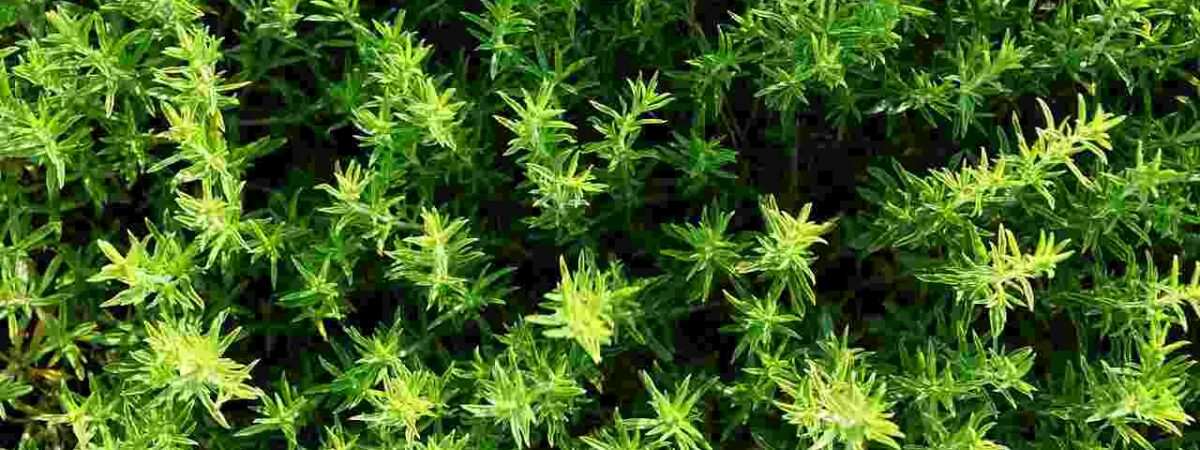Are you tired of your boring, lifeless lawn? Have you considered using culinary herbs as ground cover instead? Not only will it add some much-needed color and texture to your yard, but it can also enhance your cooking with fresh, homegrown herbs!
In this blog post, we’ll share some tips on how to choose the right herbs for your location, how to plant them as ground cover, and how to maintain them for optimal growth. Get ready to transform your lawn into a lush, herb-filled oasis!
What are Culinary Herbs?
Culinary herbs are plants that are commonly used for cooking, flavoring, and garnishing dishes. They are typically aromatic and flavorful and can be used fresh, dried, or frozen. Common culinary herbs include basil, thyme, oregano, rosemary, parsley, sage, and mint.
These herbs are easy to grow and can be grown both indoors and outdoors, making them a popular choice for home gardens and window boxes. In addition to adding flavor to dishes, many culinary herbs have medicinal properties and are used in alternative and traditional medicine.
Overall, culinary herbs are versatile and essential ingredient in many cuisines around the world.
Benefits of using Culinary Herbs as Ground Cover

Using culinary herbs as the ground cover provides several benefits beyond their culinary use. They can transform a boring lawn or garden into a beautiful and fragrant landscape, while also serving as a functional and sustainable ground cover. Unlike traditional grass, culinary herbs require less maintenance and water, making them an eco-friendly and cost-effective option.
Culinary herbs also have natural pest-repelling properties, which can help reduce the need for harmful pesticides. They can also attract beneficial insects such as bees and butterflies, which can help pollinate other plants in your garden. Additionally, some culinary herbs have medicinal properties and can be used for home remedies or as part of a holistic wellness regimen.
Lastly, using culinary herbs as ground cover can provide a source of fresh, organic herbs for cooking and seasoning. They can be easily harvested and used in a variety of dishes, adding flavor and nutritional value to your meals. Overall, incorporating culinary herbs as ground cover offers numerous benefits for both your garden and your kitchen.
How to Choose Culinary Herbs for Ground Cover?
Choosing the right culinary herbs for ground cover is essential for ensuring their success and maximizing their benefits. Here are some factors to consider when selecting culinary herbs for ground cover:
Climate zone
Different herbs thrive in different climates, so choose herbs that are suited to your specific climate zone.
Soil and light conditions
Most culinary herbs prefer well-draining soil and full sun, but some can tolerate partial shade. Take note of your soil type and the amount of sunlight your planting area receives to determine which herbs will thrive.
Purpose
Consider the intended purpose of your ground cover. Are you planting it for culinary use, aesthetics, or both? Choose herbs that will serve the purpose you have in mind.
Growth habit
Some herbs, such as mint and oregano, can spread aggressively and may take over your planting area. Choose herbs with a clumping growth habit or plant invasive herbs in containers to prevent them from taking over.
Companion planting
Some herbs are known to repel pests or attract beneficial insects. Consider planting herbs that complement each other or other plants in your garden.
Ultimately, the best way to choose culinary herbs for ground cover is to do your research and choose herbs that will thrive in your specific planting area and serve the purpose you have in mind.
Top Culinary Herbs for Ground Cover

Many culinary herbs make excellent ground cover options. Here are some of the top culinary herbs for ground cover:
Thyme
Thyme is a hardy, low-growing herb that makes an excellent ground cover. It prefers full sun and well-draining soil, and its small, fragrant leaves can be used in a variety of dishes. Thyme also has natural pest-repelling properties and attracts beneficial insects such as bees and butterflies.
Oregano
Like thyme, oregano is a low-growing herb that can tolerate dry, well-draining soil and full sun. It has a strong, slightly bitter flavor and is commonly used in Italian and Greek cuisine. Oregano also has antimicrobial properties and can be used for its medicinal benefits.
Mint
Mint is a fast-growing herb that can spread aggressively, making it a good option for filling in large areas. It prefers partial shade and moist soil, and its leaves can be used in a variety of drinks and dishes. Mint also has natural pest-repelling properties and can attract beneficial insects.
Rosemary
Rosemary is a fragrant, woody herb that can grow up to two feet tall. It prefers full sun and well-draining soil, and its leaves are commonly used in Mediterranean cuisine. Rosemary also has natural pest-repelling properties and can attract beneficial insects.
Sage
Sage is a hardy herb that can tolerate dry, well-draining soil and full sun. Its leaves have a strong, slightly bitter flavor and are commonly used in stuffing and meat dishes. Sage also has natural pest-repelling properties and can attract beneficial insects.
Chives
Chives are a low-growing herb that can tolerate moist, well-draining soil and partial shade. They have a mild onion flavor and can be used fresh or dried in a variety of dishes. Chives also have natural pest-repelling properties and can attract beneficial insects.
Parsley
Parsley is a biennial herb that prefers moist, well-draining soil and partial shade. Its leaves have a mild, slightly bitter flavor and are commonly used as a garnish or in soups and sauces. Parsley also has natural pest-repelling properties and can attract beneficial insects.
Tips on choosing culinary herbs as a ground cover
When selecting culinary herbs for ground cover, it’s important to consider the growth habit and potential invasiveness of each herb. Some herbs, such as mint and oregano, can spread aggressively and may take over your planting area if not contained. Invasive herbs can be planted in containers or raised beds to prevent them from taking over.
Another consideration when selecting culinary herbs for ground cover is companion planting. Some herbs are known to repel pests or attract beneficial insects, so consider planting herbs that complement each other or other plants in your garden. For example, planting thyme and rosemary near vegetables can help repel pests and attract beneficial insects.
In addition to their culinary use, many culinary herbs have medicinal properties and can be used as home remedies or as part of a holistic wellness regimen. Herbs such as thyme, oregano, and sage have natural antimicrobial properties and can be used to boost the immune system and fight off infections.
Overall, using culinary herbs as ground cover is a sustainable and eco-friendly way to add color and texture to your lawn or garden. By selecting the right herbs for your location and purpose, you can create a beautiful and functional landscape that also provides fresh, organic herbs for cooking and seasoning.
Maintenance of Culinary Herbs as Ground Cover

Maintaining culinary herbs as ground cover is relatively easy once they are established. Here are some tips for keeping your herbs healthy and looking great:
Watering
Most culinary herbs prefer well-draining soil and do not require excessive watering. Water the herbs deeply once or twice a week, depending on the weather and soil conditions. It is always recommended to avoid overwatering, as this can cause root rot and other fungal diseases.
Fertilizing
Culinary herbs do not require heavy fertilization, but a light application of compost or organic fertilizer can help keep them healthy and promote growth. Apply fertilizer in the spring and midsummer, following the instructions on the package.
Pruning
Regular pruning can help keep your herbs compact and promote bushier growth. Prune back the herbs by cutting off the top third of the plant or by removing any dead or damaged stems and leaves.
Mulching
Mulching can help retain moisture in the soil and suppress weeds. Apply a layer of organic mulch, such as straw or shredded leaves, around the base of the herbs.
Pest control
Culinary herbs can attract pests such as aphids, spider mites, and whiteflies. Regularly inspect your herbs for signs of pest infestation, and use natural pest control methods such as releasing ladybugs or spraying the plants with a solution of neem oil and water.
Winter protection
Some culinary herbs, such as thyme and oregano, are hardy and can survive winter temperatures. Others, such as basil and parsley, are more tender and will die back in the winter. If you live in a colder climate, protect your herbs by covering them with a layer of mulch or burlap.
By following these maintenance tips, you can keep your culinary herbs healthy and productive for years to come. Enjoy the beauty and benefits of your herbs as ground cover in your garden or lawn.
Conclusion
Using culinary herbs as ground cover is not only a beautiful way to add greenery to your garden or lawn but also a practical way to enhance the taste of your dishes. Culinary herbs offer numerous benefits such as reducing soil erosion, attracting pollinators, and deterring pests. With a wide variety of herbs to choose from, you can mix and match them to create a unique and beautiful ground cover that is both functional and aesthetically pleasing.
Remember to choose the right herbs for your climate and soil type, prepare the area well before planting, and maintain the herbs regularly. By following these tips, you can enjoy the beauty and benefits of culinary herbs as ground cover for years to come. So go ahead, try using culinary herbs as ground cover, and experience the joys of gardening and cooking with fresh herbs.
You may also like to read
7 best groundcover evergreen plants to add greenery to your garden
Discover the Top Plant Nutrients You Need for Thriving Plants






